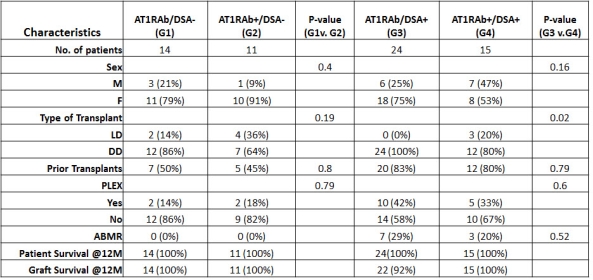Impact of Angiotensin II Type I Receptor Antibody Positivity in Highly-HLA Sensitized (HS) Patients Transplanted After Desensitization (DES).
1Kidney Transplant, Cedars-Sinai Medical Center, LA, CA
2HLA Laboratory, Cedars-Sinai Medical Center, LA, CA.
Meeting: 2016 American Transplant Congress
Abstract number: D14
Keywords: Antibodies, Highly-sensitized, Rejection, Sensitization
Session Information
Session Name: Poster Session D: Antibody Mediated Rejection: Session #2
Session Type: Poster Session
Date: Tuesday, June 14, 2016
Session Time: 6:00pm-7:00pm
 Presentation Time: 6:00pm-7:00pm
Presentation Time: 6:00pm-7:00pm
Location: Halls C&D
Introduction: Angiotensin II type I receptor antibody (AT1R Ab) is a target for non-HLA antibodies. AT1R ab exert direct effects on endothelial and vascular smooth muscle cells. Reports of AT1R ab (+) pre-transplant is associated with higher risk for acute rejection and long term graft failure (Dragun et al. AJT 2013). However, outcomes of pre-transplant AT1R ab (+) in HS patients transplanted after desensitization is not known. Here we examined post-transplant outcomes of HS patients who were AT1R ab (+/-) pre-transplant and DSA (+/-) at-transplant. Patients & Methods: From 1/31/13 to 8/8/15, 14 HS patients {G1: AT1R ab-/DSA-, PRA>80%} v. 11 HS patients {G2: AT1R ab+/DSA-, PRA~80%} v. 24 HS patients {G3: AT1R ab-/DSA+, PRA>80%}, v. 15 HS patients {G4: AT1R ab+/DSA+, PRA~80%} underwent desensitization (DES) with IVIG (2gm/kg, maximum 140gm x2 doses) + rituximab (x1) ± PLEX (5-7sessions) and transplanted. This was a retrospective review, thus AT1R ab+/- were not used in donor allocation decision. In addition, we plan to do routine monitoring of AT1R abs once identified. Results: No differences in sex (female: range 53%-91%) or history of previous transplants (range 45%-83%) in all groups; however, DD transplant was significantly higher in G3 (100%) v. G4 (80%) (p=0.02). Though not significant, no ABMR was seen in G1 or G2; whereas ABMR was seen in 29% in G3 v. 20% in G4. Patient and graft survival was 100%/100% in G1, 2 and 4 and 100%/92% in G3, respectively.  Conclusions: AT1R abs may be associated with CMR & ABMR episodes. However, in HS patients who underwent DES, DSAs appear to mediate most ABMR episodes. Thus monitoring of AT1R ab is an important facet of determining the extent of non-HLA DSA that could impact allograft outcomes. DES for AT1R ab+ alone appears to be a reasonable option for patients who are DSA- and without history of sensitizing events.
Conclusions: AT1R abs may be associated with CMR & ABMR episodes. However, in HS patients who underwent DES, DSAs appear to mediate most ABMR episodes. Thus monitoring of AT1R ab is an important facet of determining the extent of non-HLA DSA that could impact allograft outcomes. DES for AT1R ab+ alone appears to be a reasonable option for patients who are DSA- and without history of sensitizing events.
CITATION INFORMATION: Vo A, Boutsicaris C, Zhang X, Reinsmoen N, Choi J, Jordan S. Impact of Angiotensin II Type I Receptor Antibody Positivity in Highly-HLA Sensitized (HS) Patients Transplanted After Desensitization (DES). Am J Transplant. 2016;16 (suppl 3).
To cite this abstract in AMA style:
Vo A, Boutsicaris C, Zhang X, Reinsmoen N, Choi J, Jordan S. Impact of Angiotensin II Type I Receptor Antibody Positivity in Highly-HLA Sensitized (HS) Patients Transplanted After Desensitization (DES). [abstract]. Am J Transplant. 2016; 16 (suppl 3). https://atcmeetingabstracts.com/abstract/impact-of-angiotensin-ii-type-i-receptor-antibody-positivity-in-highly-hla-sensitized-hs-patients-transplanted-after-desensitization-des/. Accessed December 24, 2025.« Back to 2016 American Transplant Congress
